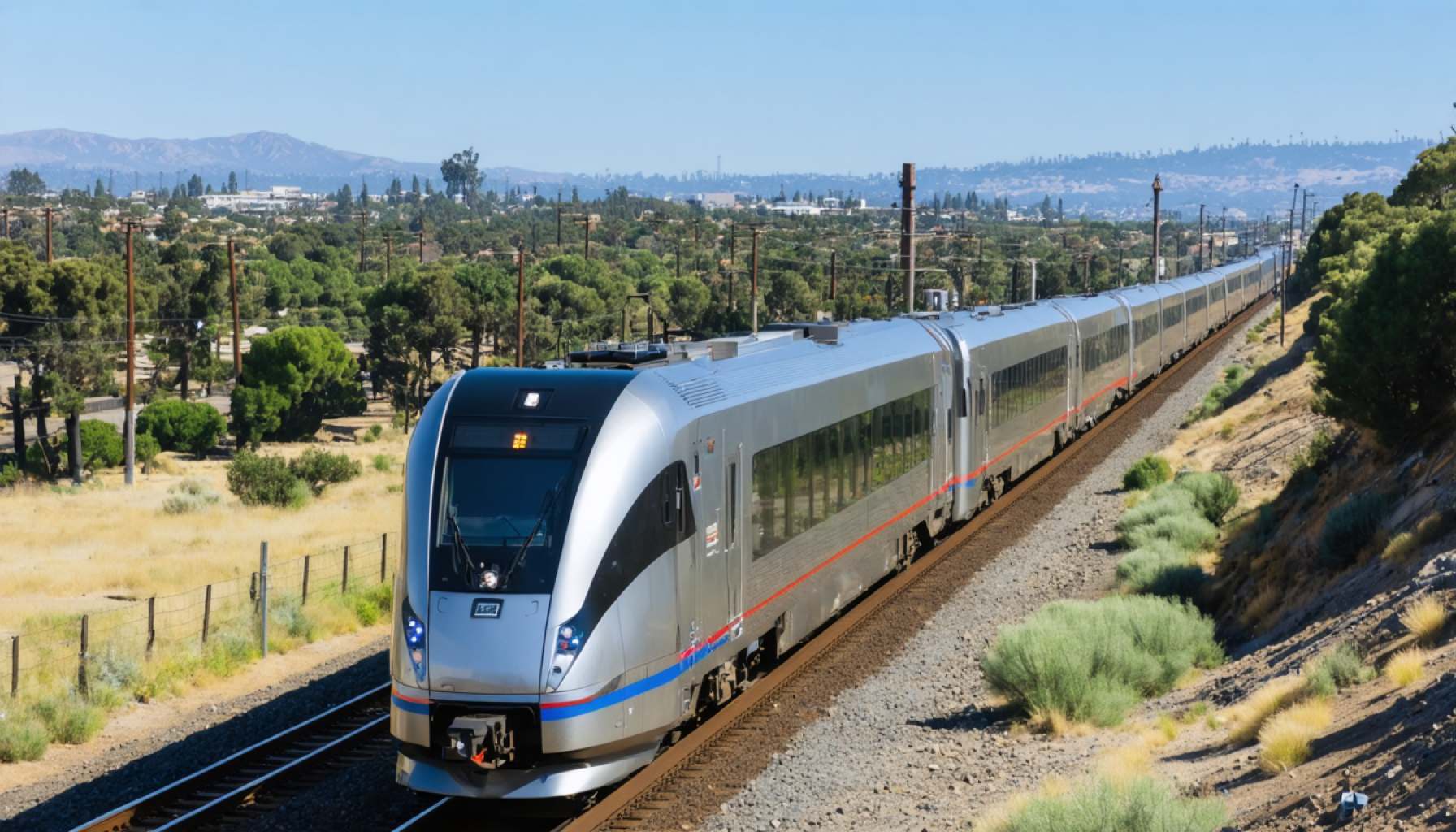- California’s rail transport is undergoing a transformation towards zero-emission technology through hydrogen fuel cells.
- Stadler Rail partners with Hexagon Purus to integrate hydrogen fuel systems, marking a shift from fossil fuels to sustainable travel.
- Hexagon Purus’s Type 4 hydrogen fuel storage systems are key to powering hydrogen-powered locomotives in California.
- The collaboration showcases a commitment to innovation and sustainability, addressing challenges in regions where electrification is difficult.
- This partnership signifies the importance of reducing carbon footprints and positions hydrogen as a viable alternative for rail transport.
- The initiative represents a shared vision for a cleaner future, with the potential to revolutionize the rail industry.
California’s sprawling vistas are poised to witness a monumental shift in rail transport. No longer relegated to diesel fumes and fossil fuel dependency, the future of its train systems glistens with the promise of zero-emission technology. This transformation rides on the shoulders of a new collaboration between Stadler Rail and Hexagon Purus, promising to redefine sustainable travel.
Imagine the auditory symphony of trains powering through the California landscape, replaced by the silent hum of hydrogen fuel cells. Picture this: sleek trains slicing through the air, propelled by nothing but clean hydrogen systems. This vision is now inching closer to our reality, thanks to the pioneering efforts of Stadler Rail in partnership with Hexagon Purus.
Stadler, an innovator in rail technology, has signed a multi-year deal with Hexagon Purus, a leading force in zero-emission technology. The agreement centers around Hexagon Purus’s cutting-edge Type 4 hydrogen fuel storage systems, set to fuel the ambitions of hydrogen-powered locomotives across California’s tracks. These systems, crafted at Hexagon’s facility in Kassel, Germany, exemplify the precision and dedication fueling this green revolution.
Hexagon Purus, renowned for its hydrogen Type 4 high-pressure cylinders, is a vanguard of zero-emission systems. Its innovative solutions span diverse sectors—rail, aerospace, maritime, and beyond. Utilizing hydrogen represents more than just a pivot for rail; it’s a harbinger of new possibilities, especially in regions like California where electrification poses significant challenges.
The collaboration between Stadler and Hexagon Purus is not merely a business arrangement. It is a shared vision for a cleaner, more sustainable future. Stadler’s leadership in alternative drive systems combined with Hexagon’s hydrogen prowess lays the foundation for trains that are both efficient and environmentally friendly.
Key figures behind this initiative emphasize the imperative of such technology. With the world seeking robust ways to reduce carbon footprints, hydrogen emerges as a beacon of hope. In rail transport, specifically, it offers a feasible solution where electrification falters, proving indispensable in the fight against climate change.
As this partnership unfolds, the ultimate takeaway is clear: the synergy between Stadler and Hexagon Purus stands as a testament to the power of collaboration in fostering innovation. The tracks are being laid for a future where the whispers of progress can be heard in the quiet, clean journey of hydrogen-powered trains. Through visionary partnerships and technological foresight, California’s railways are set to become icons of sustainable transformation.
California’s Green Rail Revolution: What You Need to Know About Hydrogen-Powered Trains
California is on the brink of a transformative era in rail transport, powered by the pioneering collaboration between Stadler Rail and Hexagon Purus. As the state embraces zero-emission train technology, here are key insights and practical considerations that reveal the full scope and implications of this green revolution.
How Hydrogen Fuel Cell Trains Work
Hydrogen fuel cells convert hydrogen gas into electricity, producing only water vapor as a byproduct. This clean process involves:
1. Hydrogen Supply: Hydrogen is stored in high-pressure tanks onboard the train.
2. Electricity Generation: Hydrogen reacts with oxygen in the fuel cells, generating electricity.
3. Powering the Train: The electricity powers the electric motors that drive the train.
4. Byproducts: The only byproduct is water, making it an environmentally friendly alternative.
Real-World Use Cases
Various regions are already exploring hydrogen trains:
– Germany: Has already launched hydrogen trains, with successful operations showcasing the feasibility of this technology.
– UK & Japan: Both countries are testing prototypes, aiming for commercial operations in the near future.
Market Forecasts & Industry Trends
– Growth: The global market for hydrogen trains is projected to grow as infrastructure costs decrease and efficiency improves.
– Investment: Numerous companies are investing in hydrogen infrastructure, eyeing long-term sustainable transport solutions.
Reviews & Comparisons
Pros and Cons of Hydrogen Trains compared to Electric and Diesel:
– Pros:
– Zero emissions
– Longer range than battery electric trains
– Independence from electrified rail lines
– Cons:
– High initial infrastructure costs
– Limited refueling stations
– Current technology requires significant space for hydrogen storage
Security & Sustainability
Hexagon Purus’s high-pressure hydrogen storage systems are designed with safety and durability in mind. These systems adhere to stringent safety standards, ensuring secure transport and usage of hydrogen.
Actionable Recommendations
1. Stay Informed: Keep up with developments in hydrogen technology, as it will influence public transport innovations.
2. Advocate for Infrastructure: Support policies promoting hydrogen fueling stations and train lines as they are key for widespread adoption.
3. Consider Multi-Modal Solutions: Explore hydrogen’s potential beyond rail, such as buses and other public transport systems.
Conclusion
As California leads the charge with hydrogen-powered trains, the collaboration between Stadler Rail and Hexagon Purus is a promising step towards sustainable transport solutions. The silent hum of hydrogen represents not just a technical advancement, but a commitment to minimizing environmental impact and spearheading a future of green travel.
For more information on sustainable transportation innovations, visit Stadler Rail and Hexagon Purus.
With the synergy of innovation and environmental stewardship, California’s railways could well become global icons of sustainable transportation.









